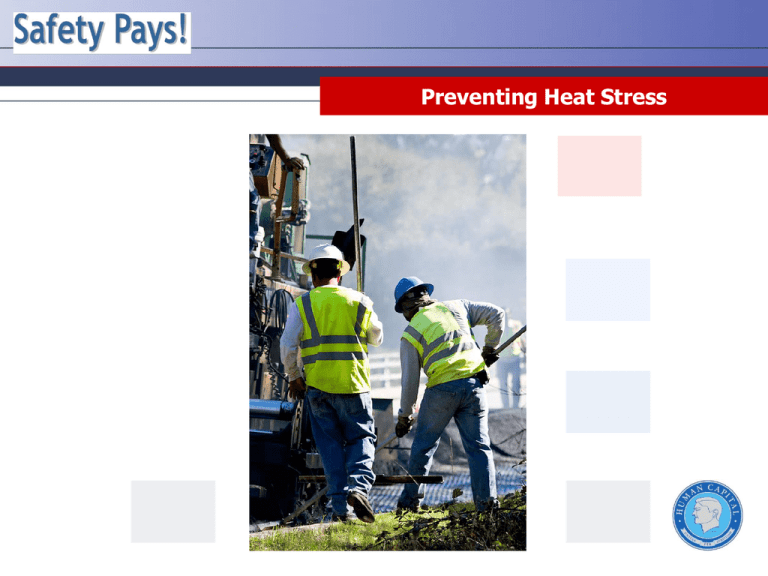Why Take the Preventing Heat Stress Training?
advertisement

Preventing Heat Stress Disclaimer • This training material presents very important information. • Your organization must do an evaluation of all exposures, applicable codes and regulations, and establish proper controls, training, and protective measures to effectively control exposures and assure compliance. • This program is neither a determination that the conditions and practices of your organization are safe nor a warranty that reliance upon this program will prevent accidents and losses or satisfy local, state or federal regulations. • All procedures and training, whether required by law or not, should be implemented and reviewed by safety and risk management professionals, and legal counsel to ensure that all local, state and federal requirements are satisfied. Course Outline – Preventing Heat Stress 1. Why Take the Preventing Heat Stress Training? 2. Physical Effects of Heat 3. Heat Stress Control 4. Heat Illness Prevention 5. Summary Why Take the Preventing Heat Stress Training? Understanding the importance of preventing heat stress: • Heat illness is a medical condition associated with the body’s inability to cool itself as it is being heated. • Fatalities occur because of this condition. • Those who work outside are at the highest risk because of prolonged exposure to the sun. • It is important that all employees use caution during the summer months. Why Take the Preventing Heat Stress Training? Thermal comfort: • A comfortable thermal environment results from control of temperature, humidity, and air distribution within a worker’s vicinity. • The following environmental factors help determine the amount of heat stress a worker can endure: – Radiant heat exchange with surrounding surfaces. – The body’s ability to gain and lose heat load. – Air temperature – Air exchange – Humidity Why Take the Preventing Introduction Heat Stress Training? Heat transfer: • Conduction: Physical contact with a • Convection: Transfer of heat to • Radiant heat: Transfer of heat to surface and transfer of heat from the surface to the human body. body surface from air. body surface from energy source such as the sun or certain job activities. This smelting operation is a source of radiant heat. The sun is an example of radiant heat. Physical Effects of Heat Heat Stroke: • Characterization: Abnormally elevated body temperature. • Symptoms: Body stops perspiration and hot, dry skin. • First aid: Remove victim to cool area, soak clothes with cool water and give water to the conscious victim. If a victim is suffering from heat stroke, immediate cooling of the body from a water source such as this garden hose is time crucial. Physical Effects of Heat Heat exhaustion: • Characterization: Dehydration caused by depletion of water. • Symptoms: Fatigue, nausea, headache, clammy, moist skin, perfuse • First aid: Give water to conscious victim. • Move victim to cool location. sweating, etc. If a victim is suffering from heat exhaustion, immediately administer small sips of water. Physical Effects of Heat Heat cramps: • Characterization: Muscle spasms caused by salt imbalance. • Symptoms: Painful muscle spasms in heavily used muscle groups. • First aid: Drink clear juice or a sports beverage to replace • Bananas are excellent sources of natural, bioavailable electrolytes. electrolyte levels and seek medical attention. If a victim is suffering from heat cramps, immediately administer sports drink. Heat Stress Control Acclimatization: • This is the process of becoming accustomed to hot environmental conditions. • Adjustments occur over the first week of exposure to heat. • The body must maintain environmental conditions at relatively constant levels and increase gradually over a 1 week period to properly acclimate. • Time will be reduced from to lack of water. Heat Stress Control Control of radiant heat: • Provide reflective shields between the heat source and worker. • Use reflective screens. • Use reflective clothing. • Cover exposed parts of body. Fire fighters use reflective clothing to reduce heat potential. Heat Stress Control Control of convective heat: • If temperature is greater than 95oF: – Decrease ambient temperature. – Decrease air velocity. – Wear clothing to cover exposed parts of body. Lowering air temperature will decrease heat stress. Heat Stress Control Control of convective heat: • If temperature is less than 95oF: – Decrease ambient temperature. – Increase air velocity. – Reduce clothing. Increasing air velocity will decrease heat stress potential. Heat Stress Control Other heat stress controls: • Drink plenty of water. • Take frequent breaks in shaded areas. • If you experience symptoms of heat stress, stop and treat the condition. • Ensure proper acclimatization prior to continuous work in hot environments. • Wear proper clothing to prevent solar load and allow cooling with specified protective equipment. Drink plenty of water in hot environments. Heat Illness Prevention Basic 5 step plan to help ensure workplace safety: 1. Develop and implement written procedures for Heat Illness Prevention. 2. Provide heat illness prevention training to all employees, including supervisors. 3. Provide enough fresh water so that each person can drink at least 1 quart per hour, and encourage them to do so. 4. Provide access to shade for at least five minutes of rest if someone believes they needs a preventative recovery period. Do not wait until they feel sick. 5. Observe behaviors and ensure personnel are following the required safety procedures. Summary Some of the physical effects of heat : • Heat stroke • Heat exhaustion • Heat cramps A few remedies for heat exhaustion: • Drink plenty of water. • Take frequent breaks. • Sit in the shade if needed. • Stop what you are doing if you feel symptoms of heat stress. • Wear proper clothing to allow cooling. • Use reflective clothing to reduce heat potential. Preventing Heat Stress This form documents that the training specified above was presented to the listed participants. By signing below, each participant acknowledges receiving this training. Organization: Trainer: Trainer’s Signature: Class Participants: Name: Signature: Date: Name: Signature: Date: Name: Signature: Date: Name: Signature: Date: Name: Signature: Date: Name: Signature: Date: Name: Signature: Date: Name: Signature: Date: Name: Signature: Date: Name: Signature: Date: Name: Signature: Date:






